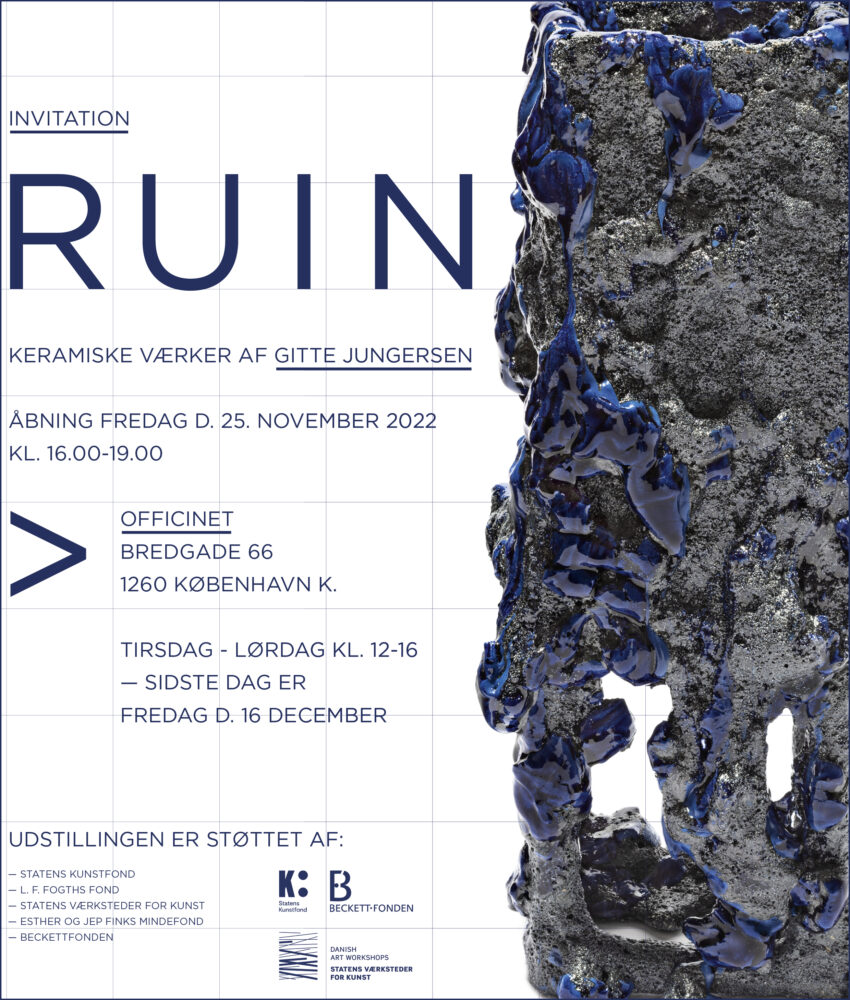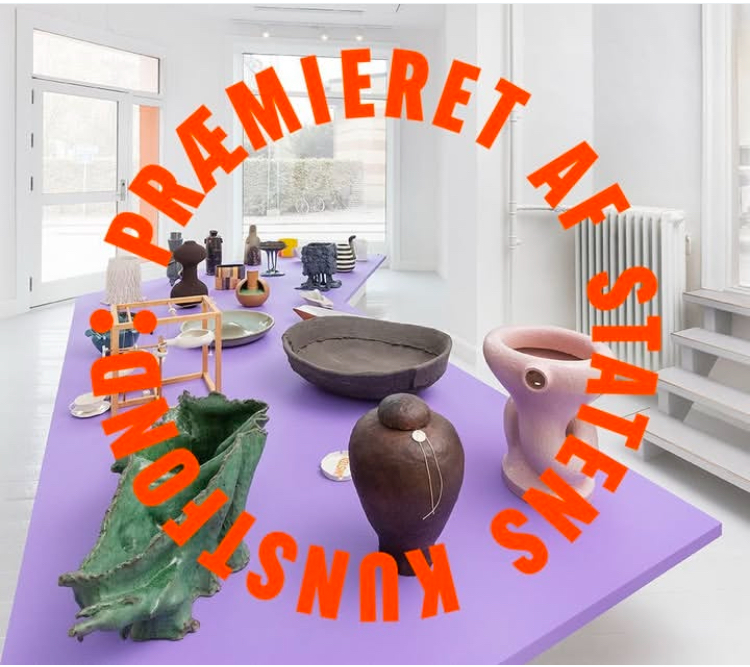
CONTENT awarded by Danish Arts Foundation


Ole Jensen and me wrote 25 texts about the 25 objects featured in CONTENT.
Here it is,- read an excerpt of my text about Bente Skjøttgaard below.
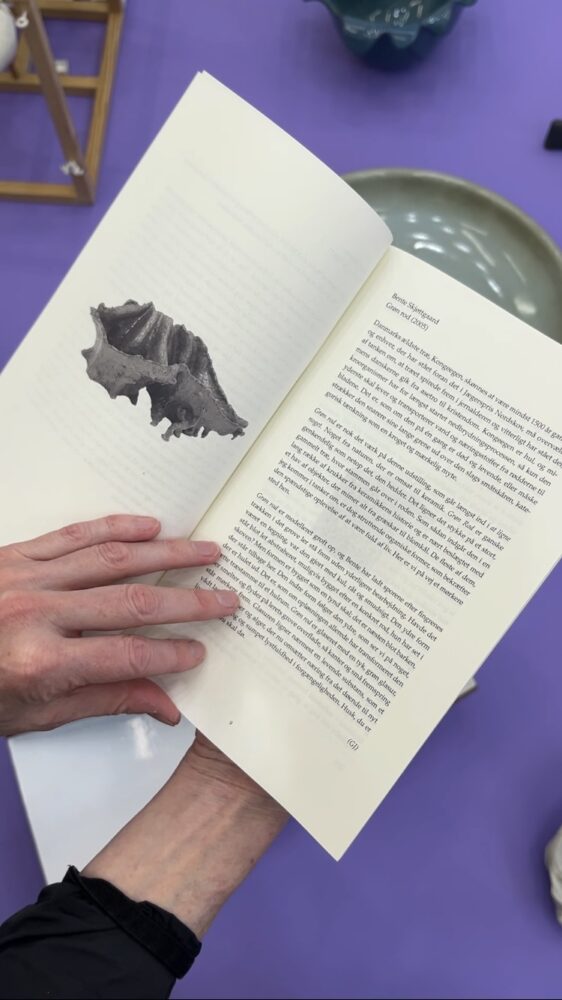
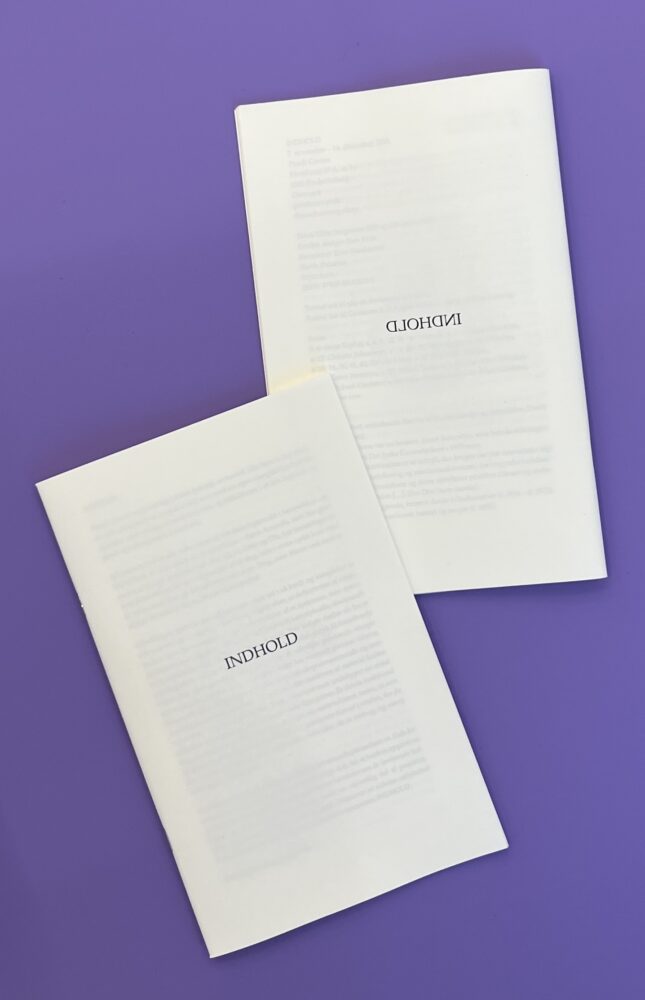
‘Green Root is roughly modelled, and Bente has allowed the traces of her fingers pulling on the coarse clay to remain, without additional finishing. Had it been a drawing, it would have been done in charcoal, rough and dirty. The outer form is only slightly abstract, perhaps modelled on a concrete root she saw in the wood? But it is constructed as a thin shell, as if only the bark remains. The inner form follows the outer, as if the object we see has been hollowed out. It seems as if the dissolution has already transformed the dense tree trunk into a cavity. Green Root has a thick green glaze that melts and flows over the coarse clay surface, causing edges and small protrusions to appear darker and more visually prominent. The glaze looks almost like a living substance, a wet layer of mosses and algae that is now metabolising nutrients from the dying form to generate new life. The decay has a heavy, swampy sense of pleasure and desire. Remember: you are fortunate enough to be mortal.’
The exhibition is curated by designer Ole Jensen and me.
Opening 7. November at 5 pm.
The themed exhibition CONTENT presents a curated and diverse selection of 25 vessels created by Danish ceramicists over the recent decades. Together, the 25 objects explore the full spectrum of ceramics, from the most basic everyday functions to existential questions. In the 25 texts in the accompanying catalogue, we gaze into the vessels to see what sort of content they might hold.
What we found: everything from ashes to concept, from shit to materialized poetry, sometimes within one and the same vessel! We found beauty, design philosophy, humour and social satire, conceptual and narrative CONTENT.
In ceramics, the vessel is both a convention and a mainstay: a type with a rich history that defines the field. We selected some of the vessels that have made the biggest impression on us, because they offer an interesting take on the vessel as type. They are objects that continue to haunt us and which are therefore well worth revisiting! The result is a collection of ceramic pieces that evade definition as they morph in and out of different genres. Are we looking at a sculpture, a utilitarian object, a materialized idea, a pure experiment? For the objects on display, the answer is never either-or. They defy categorization, they are both-and – and that is part of their impact and allure.
The catalogue received support from the private foundation Grosserer L. F. Foghts Fond.
7 November – 14 December 2024
Anne Tophøj, Bente Hansen, Bente Skjøttgaard, Bodil Manz, Christin Johansson, Christina Schou Christensen, Claydies, Flemming Tvede Hansen, GitteJungersen, Hans Vangsø, Hilda Piazzolla & Alma Bangsgaard, Jørgen Hansen, Karen Bennicke, Kristine Tillge Lund, Lone Skov Madsen, Martin Bodilsen Kaldahl, Mette Marie Ørsted, Michael Geertsen, Morten Løbner Espersen, Ole Jensen, Peder Rasmussen, Petra Dalström, Sisse Lee, Turi Heisselberg Pedersen, Ursula Munch-Petersen
Opening event on Thursday, 7 November 2024 from 16.00 to 19.00
(Free catalogue on the opening day)
Anders Kolt Rasmussen, art historian and curator at CLAY Museum of Ceramic Art Denmark, will give the opening speech at 17.00.
NB On Saturday, 30 November, at 13.30, the exhibition curators, ceramic artist Gitte Jungersen and designer Ole Jensen, will give a talk about the concept of the exhibition and the featured objects.
Peach Corner
Howitzvej 67A
2000 Frederiksberg
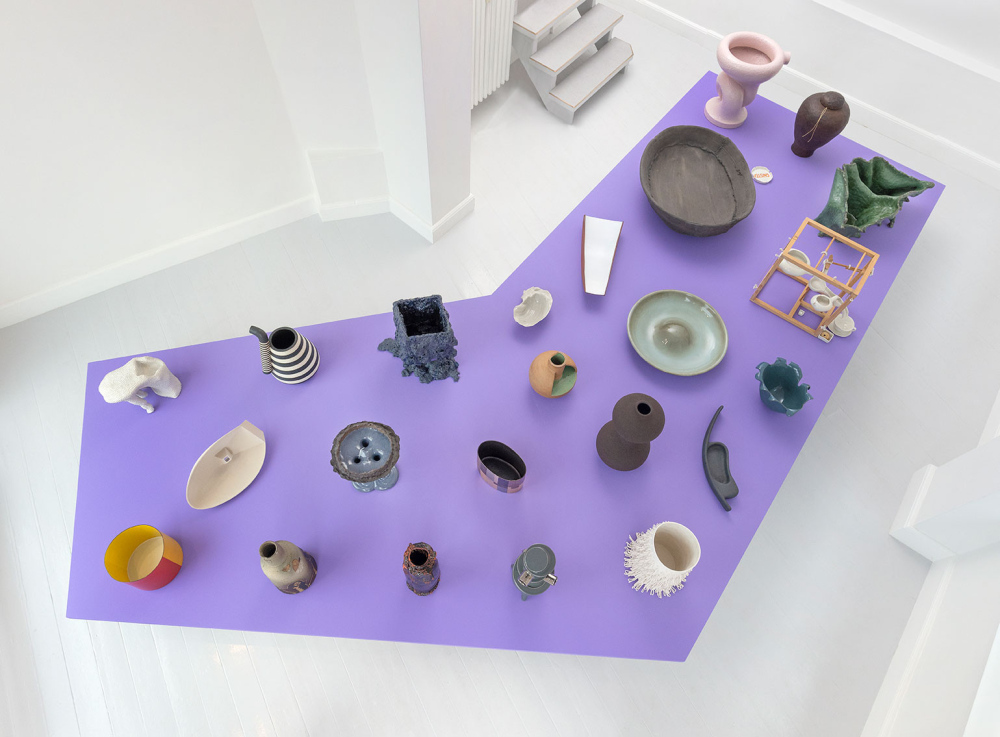
I will be part of the exhibition Peach Melba !
Dezeen has appointed the exhibition to be one of 12 Must See exhibitions during 3Days of Design!
Come and visit in Frederiksgade 1, 4th floor, room 413, 1265 Copenhagen.
Opening hours: 12-14 June 2024 at 10.00 – 18.00

My work Ruin #1 is shortlisted for the Officine Saffi Award, and part of the exhibition (un)Known Territories.

(un)Known Territories, May 29th – July 31st 2024
Fondazione Officine Saffi
Via Niccolini 35A
20154 Milan
https://officinesaffi.org/en/award/award-5
There is constantly something happening
Caroline Slotte (FI) and Gitte Jungersen (DK) 28 September – 5 November 2023
Line Ulekleiv, Art Critic and assistant professor at KHIO, gives the opening address at 6 pm.

The exhibition The Magic of Ceramics presents a large selection of works from the CLAY Collection.
My Yellow Cube from 2003 is part of the exhibition. Opens 30 June 2023.

The exhibition The Magic of Ceramics presents a large selection of works from the CLAY Collection. For more than 250 years, Danish designers have explored, developed, and refined the ceramic expressions with skill and know-how, artistic ambitions, curiosity, and passion. Tirelessly, they have experimented with clay mixtures and glaze effects and unfolded their imagination and narrative enthusiasm.
The following seven themes: Design & Concept, Form, Ornament, Narratives, The Human Figure, Nature, and Glaze show the numerous expressions represented in the collection – across time, artistic schooling, techniques, and styles. In the middle of the exhibition, the technical and artisanal processes are shown. Right from digging up natural clay, via techniques of shaping, glazing and firing to the final expression of the ceramic object.
A fascinating process which demands know-how, skill, and respect for detail in the mastering of the wonderful magic of ceramics.
see the museum webpage for opening hours.
A Quivering Undertone
The objects in the Ruin exhibition were created during a residency at the Danish Art Workshops in autumn 2022. In a sense, Ruin is a continuation of former series of works, but this time, I have returned to the scene of the crime with a different approach. The objects refer at once to the familiar ceramic archetype of the vessel and to a more open, abstract structure that sparks associations pointing in many different directions. To a ceramic artist, the vessel is almost like the painter’s white canvas: a starting point that can be reinterpreted over and over in a search for new and contemporary expressions. I previously worked with cubic vessels, their simple shape providing a basis for the organic movements of glazes (the Cubes series, 1995–2007). Another project that this exhibition draws on is Deform from 1995–97. It consisted of a series of basic geometric shapes that were exposed to ever higher temperatures, causing them increasingly to melt and transition towards something formless and lumpy.
My work on Ruin unfolded as one big experiment, as I chose to maximize the loss of control that the firing always represents in the ceramic process, where melting is a crucial factor in the emergence of the expression. I let the glazes flow freely, virtually dissolving the surfaces as they slid down the form. I also pushed the shape of the objects to the point of compromising their integrity, causing some of them to deform and come close to collapse. In many of the objects in this series, the vessel’s inner cavity is just as significant as its exterior form due to the mass of glaze flowing down the inner walls and creating the impression of a landscape or a grotto inside the object. These massive layers of glaze create an expression reminiscent of geological processes, and to me, the objects occupy a position in between the raw powers of nature and man-made cultural objects.
All the glazes are coloured with cobalt oxide, a politically ‘hot’ metal that is used in lithium ion batteries and hence a highly sought-after and limited resource. In the chemical composition of the different glazes, the cobalt unfolded in varying shades of colour and texture, ranging from a greyish blue lava-like mass to a deep blue high-gloss shine. In ceramics, cobalt is known from the time of the Chinese Tang Dynasty in the 7th century and all the way up to today’s blue fluted porcelain. In a glaze, cobalt oxide can result in anything from a cheap ingratiating tone to an aristocratic blue.
In my approach to ceramics, the material is constantly exposed – there is constantly something happening to it, and the objects emerge as an accumulation of processes that are deposited as a representation of energy and time in the physical matter. I pushed the forms and glazes to the edge of what is possible, building too tall and spindly, too big and thin, firing at too high a temperature. I covered the objects with huge amounts of different glazes, sometimes layering glazes with opposite physical properties: some layers bubbling up and expanding, others contracting into flakes or running and pooling into deep lakes. I fired objects multiple times, added new layers of glaze and then fired them again at a higher temperature, driving the object to ever higher levels of deformation. I did not stop until an object had attained a certain quivering expression, teetering on the edge between creation and destruction. The objects may appear to be in a transformative process, representing a tangible point on the object’s timeline, since just as there is a ‘before’, there will also be an ‘after’. Ultimately, the objects are going to break up completely, dissolve and enter into new physical manifestations.
Gitte Jungersen
Caroline Slotte (FI) and Gitte Jungersen (DK) 13 April – 20 May 2023
Pernille Stockmarr, curator at Designmuseum Danmark, gives the opening address at 17.00
There is constantly something happening
Ceramics can be transformed in a split second if they are accidentally dropped and shatter. Or they can be slowly worn down – touched by hands, scratched by cutlery, their surface eroded by wind and weather. From the moment of creation, any object is also an incipient ruin, since, just as there is a ‘before’, there will also be an ‘after’. Over time, the objects are going to break up completely and enter into new physical manifestations.
Caroline Slotte’s works begin with antique porcelain plates. She sandblasts, grinds and cuts her way into the materi-
al, bringing new poetic images out of the familiar utilitarian objects. In her series Tracing, a miniature sandstorm has swept the original pieces, removing layer after layer of material. A landscape painted in cobalt blue, a sky, a cloud, a tiny person – the image is slowly eroded away, turning into white dust on the workshop floor. The flat blue painted scene gradually transforms into something akin to an imprint or an X-ray image, as if a memory of the image had sunk into the surface and is now slowly emerging as a three-dimensional recollection. In Under Blue Skies, all that remains is a few blue clouds. The clouds, which were originally added as background on the outer edge of the central image, move to the foreground, now accompanied by an outline of the elements that have been eroded away: a church, a tree, a floral border. The vanished areas can be glimpsed as negative forms in the white porcelain body.
In Gitte Jungersen’s large glaze objects, creation and destruction seem like two extremes that are closely connected. Piece #2 and Piece #3 consist of different glazes poured out in thick layers. Usually, even on a large sculpture, the glaze is only present as a thin layer, but here, the glazes take on a format that mirrors the human body. Like a blown-up detail or something seen through a microscope. All the glazes are coloured with cobalt oxide, which in the chemical make-up of the different glazes unfolds in varying colour shades and textures, from a greyish blue lava-like mass to a deep blue high-gloss shine. Glaze comes into being when different raw minerals coalesce and transform, becoming something new as a result of the firing’s dramatic, destructive and disintegrating forces. The transformation which occurs during the firing is retained as a frozen moment of a dynamic dimension that is felt and attracts like a quivering undertone in the finished work.
Text by Gitte Jungersen, published in the book Gitte Jungersen, Ceramic Works, Arnoldsche Art Publishers 2018.
A frozen moment
Ceramic can be defined as clay and other mineral materials that are fired at a high temperature and subsequently cooled. It is the firing that makes ceramics what it is, and to me, that has always been the most intriguing aspect, the process that distinguishes ceramics from other media. Ever since I began my training, I have been fascinated with the dramatic transformative process of kiln firing and its inherent potential to bring out both meaning and formal aspects.
Ceramic glaze consists of minerals that are extracted from the earth’s crust and refined. The minerals are the result of geological processes. One of the most common raw materials in my glazes is feldspar, which makes up 60% of the earth’s crust. Another mineral I often use is calcium, which is the main component of our bones. I buy it from the Faxe Kalkbrud quarry, where it is extracted as limestone, composed of fossilized remains from marine organisms that lived millions of years ago. A small amount of calcium causes feldspar to melt when fired, and the right amount of quartz produces a deep, shiny glaze.
I have always been fascinated by ceramics as a cultural refinement of raw materials that enter into a dialogue with nature’s own processes. There is a parallel between the process of melting and transmutation and the powerful forces at play in geological erosion and in the raging fire that is constantly transforming the minerals in the earth’s core.
In the kiln, the materials undergo a gradual change, and at top temperature the transmutation peaks: the glaze becomes a boiling, liquid mass where minerals melt, and atoms switch places, bonding together to form new molecules. Destruction and creation at once. – What was once a calcium atom in a starfish skeleton is now part of a deep blue glaze.
I develop experimental glazes, aiming for combinations that react as dramatically as possible when melt, boil, bubble and crack. As they cool, the transformation seizes abruptly, and the works appear as frozen moments from the melting process. My aim is to convey an experience of matter captured in mid-transformation, a material point in time: just as there is a before, there will also be an after. Over time, the objects will erode, dissolve and enter into new physical compounds.
My inspiration comes from nature, but equally from city streets and from materials that have been modified or shaped by humans: a petrol spill shimmering in a puddle, melted plastic on a burnt-out plot, the stark colours of an ice-cream wrapper tossed in a landscape. I seek to capture this duality by creating complex materials with multiple layers of meaning, often incorporating bright colours and sparking associations to both primordial matter and synthetic materials in a process of melting and transmutation.
My method is based on systematic experimentation, including carefully weighing and testing everything. Working with the chemical composition of glazes is often described in romantic terms, but to me, it is not about mystery or magic; rather, it is a stringent analytical process, where I strive to gain full control over the reactions of the individual glazes at 1280 degrees Celsius in a computer-controlled kiln. I deliberately use glazes that react dramatically and with maximum movement when they melt. When glazes with very different properties are layered on top of each other, there arises an aspect of unpredictability as the materials take over, and the expression balances between raw natural power and human-made cultural object.
Over the years I have sought increasingly to let go of control and allow the melting to take over as the formative process. In works from recent years, the glaze is no longer merely a coating on the ceramic body but a standalone element that is used in such great amounts that the glaze itself becomes the form. That does not happen until the glaze melts in the kiln and flows, pulled by gravity, outside my control. In this unpredictability and loss of control lies the possibility of entering into a dialogue with the materiality on equal terms in a process where the material answers back. By contrast, the clay provides a stable form and support structure as the element that stands still, providing a simple, geometric frame for the wild and organic melting of the glazes.
Introduction from the book Gitte Jungersen, Ceramic Works. Published by Arnoldsche Art Publishers 2018.
Lars Dybdahl is former Head of Research at Designmuseum Danmark.
INTRODUCTION
In the circle of outstanding ceramicists who have earned Danish contemporary ceramics its global recognition, Gitte Jungersen operates continuously and with great intensity at the autonomous end of the spectrum. The pole where the craft plainly disregards its latent potential as a source of innovation for new industrial products intended for our aestheticized everyday life to unfold instead in a sculptural exploration of material aesthetics and dissolving boundaries – in objects that qualify as works of art.
In the ceramic diversity at play in this artistically potentiated field, ‘eternal’ vessel types are rejected or transformed, and the ceramic material is generally liberated from rationality and regularity of form. This leaves the objects free to examine its own creation and character and to take on associative, narrative and conceptual roles, thus pointing to the larger world, challenging conventional thinking and enhancing vitality. The sculptural expression may also be applied to larger installations, where several components form a complex and extended work of art on wall surfaces or in three-dimensional space.
In her far-reaching, high-profile oeuvre Gitte Jungersen has covered the full spectrum from the expressive to the conceptual. In mobilizing her ceramic material she has not only opened the floodgates to the ancient textural qualities of clay and glaze; she has also orchestrated contrast-rich meetings, where ceramic engages in physical and meaning-generating interplay with other materials, for example from the pop-culture super-hero universe, with a plastic Spiderman figure being transferred to the large scale of a ceramic installation that includes other object types. Or in her series Place to Be Lost, where corny and kitschy elements, in the form of small trivial animal figurines in high-gloss porcelain, are assigned a surprising role to play in her characteristic landscape formations of lava-like, eruptive glaze. Never a ‘Danish-Japanese’ minimalist, she engages in analytical processes where her reflections and experiments focus primarily on the expressive colour and form potentials of glazes.
In Gitte Jungersen’s production, the engagement with liquid glazes – one of the characteristic elements of new Danish ceramics – is taken to extremes. While ceramic glazes are normally used to decorate the ceramic body, in her works they assume a startling, independent identity. In the vertical sculptures in her series of ‘Little Hybrids’ the organic glaze substances form a colourful ‘plastic explosive’ on the upright rectangular frames. And in her large glaze objects from recent years, the glaze has taken over completely. While ceramic glazes traditionally serve as decoration, here, the multi-layered objects attain a state of autonomy as substantial forms in their own right, without a clay body.
Just as bubbles are a rich, often clustered, recurring motif in her work, the large objects made of combined glazes capture a single moment in time, as sudden cooling has ‘frozen’ the hot, liquid glaze in its boiling, seething stage. The possible resemblance of the glazes to minerals returning to their original state in the earth’s crust does not mean that Gitte Jungersen seeks or strives for any ‘deep’ essence of the ceramic means of production. In a time defined by radically renewing technological development processes and smart, intelligent material design, her intense fascination with the hybrid and mutating is, by contrast, associated with the current absence of fixed material identities. In harmony with the postmodernist breakthrough in ceramics Gitte Jungersen also abandoned the static, emotive and nature-simulating tradition in Danish ceramics and struck out on her own path with expressive and transformative abstractions on the cubic vessel. A form that is in itself far removed from common everyday types and thus appears strictly as a rhetorical reference to utilitarian forms and functionality. One of her choices in this process was stark, artificial colour notes, a sign of the times, and, in her distinctive work, a reflection of an innovative temperament.
Text from the book Gitte Jungersen, Ceramic Works. Published by Arnoldsche Publishers 2018.
Jorunn Veiteberg, D.Phil., art historian, independent writer and researcher.
Between Control and Chaos
Gitte Jungersen belongs to a generation of ceramists who have done a great deal to change people’s conceptions about what ceramics can be. When she made her debut in the 1990s, pots based on shapes that were basically geometrical, were still the standard repertoire of Danish ceramists. Her first work was no exception to this rule. At the Charlottenborg Spring Exhibition in 1995, she showed a number of cubic vessels. It was even so not form and function that these invited the observer to reflect on, for it was already obvious in these early works that what interested her most is the glaze: viscous and full of porous air-bubbles, it forms a contrastive mass to the strict cubic shape.
Not to make the glaze subordinate itself to or merely enhance the form was a breach of long-standing conventions within the field of ceramics. A convention Jungersen was familiar with from her own education from 1988 to 1993 at the Danish School of Design in Copenhagen, where the ideals from Bauhaus and modernism still reigned supreme. This also meant that the main focus was on the production of functional design. But her own preferences were more far-ranging. Her models were the Dane Gutte Eriksen (1918-2008) and the American Ron Nagle (b. 1939). It is harder to imagine more contrasting artists than these, but in Jungersen’s work it proves possible to unite them in an original way. Not in the sense of their being traceable as direct quotations; it is more a question of a kinship of attitude and approach. Gutte Eriksen had studied under Bernhard Leach and there become acquainted with Japanese ceramics. From this tradition she took with her an interest in what can be referred to as the basic element of ceramics. She mixed her own clay and was deeply taken up with what the firing temperature and addition of fire and air during the firing process could add to the surfaces of various textures and colour nuances. Jungersen share the interest for exploring the actual material and firing process, but she departs from the traditional attitude to glazes. Eriksen’s simple, classical pots are based on the idea that form and glaze are a totality, and that it must be possible to read the way in which the pot has come into being from the end-product. In Jungersen’s work, the glaze is ‘allowed’ to follow its own paths, and this often plays a major role.
Ron Nagle resided in California and his ceramics are typified by a life of surfing, rock music and the ‘hot-rod’ culture. Colours such as lilac and pink, and glazes that resemble a viscous layer of smooth, dripping chocolate, point more towards cartoon series, grafitti and popart than ceramic traditions. At the same time, his small sculptures nearly always have the cup as their point of departure. They are often composed of various elements, and he is also extremely free in his combination of techniques and material. The orientation towards contemporary culture, high as well as low, and the use of synthetic colours are also things Jungersen shares. This was especially demonstrated by her pink and green cubes at the exhibition New Danish Ceramics at Designmuseum Danmark in 2003. Such a use of colour was still unusual in Danish ceramics at a time when ‘natural’ colours were the preferred ideal. Jungersen’s colours had more associations with something artificial than with ceramics, and therefore functioned as a means of creating distance. That was the intention. She has never sought traditional beauty and harmony, but always introduces a disturbing element. The plastic-like colours lent her ceramic pieces an aura of pop-culture and humour. That this choice also included an indirect critique of other sections of the Danish ceramics environment, which was characterised by a more romantic approach to the discipline, should not be concealed either.
A new type of ceramics
In the 1990s, the most important arena in Denmark for the type of ceramics that Jungersen represented was the artist-run space Udstillingssted for Ny Keramik, which existed from 1996 until 2000 in Copenhagen.1 The exhibition venue ‘aspired to engender a debate around the very notion of ceramics, internally within the profession. At the same time it endeavoured to effect a change in public expectations.’2 When it closed down after four years, those involved were able to ascertain that in addition to having created a space for experimental and conceptual ceramics they had also contributed to outlining the contours of a new generation of ceramists. This generation, to which Jungersen also belongs, still forms the central hub of Danish ceramics.
Together with Flemming Tvede Hansen, she was behind the 1997 exhibition ‘Deform’ at the Udstillingssted for Ny Keramik. The title emphasises the dissociation from the insistence on perfection that has occupied such a strong position in Danish design. Closely linked to conceptions of the perfect is also the idea that an ideal form exists. It was such conceptions that ‘Deform’ thematised – and effectively punctured. The exhibition comprised a series of vessels. As their point of departure, all of them had been made based on the same geometrical ball-shape, but during the firing they had been halted at various stages of a deformation process. By changing the temperature in the kiln the clay had been pushed past melting point. This meant that the shapes ranged from an intact ball shape to a molten lump. The static ideal form had, in other words, been transformed into an organic, fluid movement. Although each part of the series can be said to be a unique object, it is the series that creates the narrative. In that way, the process becomes part of the content. As they themselves formulated it: ‘The exhibition can be seen as an experimental investigation into creating a sculptural expression on ceramics’ own premises, inasmuch as the design is based on the actual chemical process which is set into motion when the clay is fired.’3 This resulted in new, strange and unique shapes that support the assertion that a perfect shape is a transient shape. Many artists share this attitude towards perfection. The perfect is perceived as being static and regulated, cold and hard. If art is to be an expression of freedom, there must be room for the unexpected, surprises, risk-takings, and that means that the irregular and deformed rather than the perfect is more likely to characterise artistic quality.
A new platform for ceramics came into being in Denmark with the advent of the gallery Copenhagen Ceramics, which Bente Skjøttgaard, Steen Ipsen and Martin Bodilsen Kaldahl operated between 2012 and 2014. It too was an idealistic step taken to promote contemporary ceramics, but this time in a closer cooperation with the international scene. Also here Jungersen was one of the exhibitors, and for her too the 2000s were characterised by increased international participation. In 2008, she was a jury member and exhibitor at the Biennale in Vallauris in France, and she has been active in the Network for Nordic Contemporary Ceramics since its establishment in 2013.4 The underlying reason for creating such a network is the need for a forum where people can reflect on and discuss present-day ceramics. The ten members of the network have both been on study trips and held exhibitions together, and as artists they have all stood for an experimental and non-dogmatic approach to ceramics.
Glaze as material
Experimenting with glazes has been Jungersen’s prime concern. The desire to create a new form of expression in glaze has taken her in various directions. Via chemical experiments involving mixing mineral raw materials she has developed her own glazes. To be able to create one’s own materials that are both unique and complex has been satisfying in itself, but it has also been a question of exploiting what glaze is as a phenomenon. Of key interest here is the firing, where the major transformations take place. At maximum temperature in the kiln, the glaze turns into a melting and boiling substance which on cooling congeals into an after-image of this process. She also plays on the associations glaze gives rise to as a physical mass. Concerning the thick layers of glaze on her cubes Love Jönsson, for example, wrote in a catalogue: ‘[T]he impression one gets is that a layer of lava from the volcanic underground has formed a drape over the pure geometry of culture.’5 Jungersen herself has also commented on the dramatic aspects of her work methods: ‘The process is driven forwards via experiments with extremely active glazes that, during the firing, boil and crack in a way that reminds one of geological processes. After cooling, the surfaces are now congealed traces of the violent transformation, like snapshots from a dramatic process.’6 In this way, the firing process can serve as an image of the cycle that applies to all materials. Sooner or later, all substances dissolve into atoms and enter into new combinations. But it can also serve as an image of a tension between what is manmade and the forces of nature.
The masses of glaze gradually form excrescences on the cubes and they acquire an increasingly independent nature. In a series of wall objects from 2007-08, Jungersen exploits their organic nature and lava-like surface to create landscape-like formations. On these she placed miniature plastic figures of various animals, or cartoon heroes such as Spiderman, or even small trees. These are well-known objects from children’s playboxes, but here they are placed in a completely new context. As the curator Rikke Rosenberg stated in connection with a solo exhibition of a number of these works at Designmuseum Danmark in 2008: ‘Landscape and elements collide, with the result that the frames of logic explode and the portals to the space of the dream and imaginative conceptual representation open up.’7
The use of figures opened up the potential for stories and dramas of a different type than those that had dealt solely with the basic elements of ceramics. In the series ‘Place to be Lost’, which was created between 2010 and 2014, porcelain dogs and elephants were on the point of drowning in a mass that surges in over them like boiling lava. They are quite literally stuck fast, it would seem. In this way, the actual processing of the material underpins the thematic content. The illusion that Jungersen has created of a sticky substance has a particular effect. There is nothing as repulsive as a material that is halfway between liquid and solid, the anthropologist Mary Douglas claims in her book Purity and Danger. We are quite simply disgusted by what is (apparently) sticky. The animal figures form a contrast to the mass of glaze. They have a smooth and shiny surface and their consistency seems to be solid and hard.
The porcelain figures have not been modelled by Jungersen, but have been found in second-hand shops. Some of them belong to fine collector’s items from The Royal Danish Porcelain Manufactory, others are cheap knick-knacks. But in their new context the porcelain figures become distanced from their history and aura of something sweet and romantic. Instead, they become more disturbing and nightmarish. This became even more obvious when they were exhibited on antique furniture at the international ‘Thing Tang Trash’ exhibition at the Art Museums in Bergen in 2011. The associations with respectable bourgeois homes formed a stark contrast to the struggle being expressed in Jungersen’s objects. From children’s books and fairytales we are used to projecting human attributes onto animals, and it ought not to be difficult to identify oneself with the drama being enacted in these scenes. If one so wishes, one can interpret this drama as a portrayal of the studio ceramist’s lonely struggle and dialogue with the material, with the artist alternately in control and submitting to the force that exists in the material itself. This struggle is depicted with an eye for both the absurd and the comical. At the same time, Jungersen emphasises that for her this type of objects have to do with identity, professional as well as personal. More precisely, with the disquieting aspect of exposing oneself to uncontrollable states where one lives in the tension between the fascinating and the repellent.
The incorporation of found objects became a means for Jungersen to finally break free of the vessel tradition. In this respect, they represent an important phase in her art production, even though she now regards them more as a parenthesis. Instead, it is working with large surfaces of glaze that has mainly preoccupied her in recent years. The first time she showed such works was in 2016 at the exhibition ‘All is Flux’, which she shared with her colleague Kristine Tillge Lund at Gustavsbergs Konsthall outside Stockholm.
The material in these objects is exclusively made up of layer upon layer of glaze. Initially, they are shaped as a strict rectangle, but during the firing they melt and flow into organic fields of glaze. Control and loss of control is also the basic theme here.
Large surfaces and small sculptures
The format has steadily increased. During a working stay at the Oslo National Academy of the Arts in winter 2017, she produced her largest sculptures so far, and these were for a solo exhibition at Bagsværd church in Denmark. Form and format, according to her own statement, have been ‘conceived as an echo of the very strict system of measurements that makes up the gallery passage, but a diffuse, organic echo, while the building is otherwise characterised by strict lines.’8
The two sculptures are composed of the same glazes, but the mixture is slightly different. In this way, they appear to be ‘the same, yet different’.9 The choice of format also expresses a desire to work in a scale that reflects the size of a human body. As she writes in an accompanying exhibition text: ‘I’m keen to unfold the potential of ceramics to communicate physically and sensually – not predominantly visually optical. Therefore it has been important for me to work in this pretty large format.”10
Many of the larger works are kept in dark colours. At a distance they can look black and monochrome, but at close quarters they will reveal a rich interaction of blue, grey and black nuances, and the texture will also be seen to be rough and tactile. Thick layers of her selfmade glazes have been mixed with bought earthenware glazes, and occasionally mother-of-pearl lustre additionally adds life to the surface.
In a series of smaller objects, Little Hybrids, from 2015 onwards do plastic-like colours in bright, synthetic colours once more become predominant. Over a strict basic structure which can resemble a frame, extremely thick layers of glaze have congealed in a movement of free fall. When these objects were shown at KRAFT Bergen in Norway, Jungersen described them as being both inviting and repelling at one and the same time: ‘The glazes, because of their consistency and colours, give rise to dual associations: As a raw, chaotic natural force, but also artificial in their colours and consistency – like an “edible” substance that is delicious like sweets but also almost like an alien, overwhelming mass that takes over the form.’11
Making ceramics has to do with processes that take time. It starts with a formless raw material that one is to mould into a fixed form. This means everything from controlled and analytical work to a more or less large gamble. It is to this type of history and process that Jungersen’s objects bear witness. ‘My work springs from a fascination with the transformation in ceramics from formless raw materials into melting and hard-fired congealed movement,’ she writes in a statement from 2016.12 The duality that lies in this transformative process between coming into existence and dissolving, control and chaos constitutes the core of her ceramic art.
Jorunn Veiteberg
Notes
1. The gallery was started by the ceramists Turi Heisselberg Pedersen, Lone Skov Madsen and Mark Lauberg, and the circle was later expanded to include Bente Skjøttgaard and Michael Geertsen.
2. Ny keramik / New Ceramics. Udstillingssted for ny keramik, Copenhagen: Forlaget Rhodos 2002, p. 7.
3. Ibid., p. 28.
4. Apart from Gitte Jungersen, the members of the network are Heidi Bjørgan (NO), Christin Johansson (SE/DK), Kristine Tillge Lund (DK), Mårten Medbo (SE), Gustaf Nordenskjöld (SE), Irene Nordli (NO), Kjell Rylander (SE) and Caroline Slotte (FIN).
5. Love Jönsson: ‘Gitte Jungersen. Something warped and more demanding.’ Gitte Jungersen. No listed year, p. 5.
6. Unpublished note from Gitte Jungersen.
7. Rikke Rosenberg: ‘Place for a Secret. Ceramic sceneries by Gitte Jungersen.’ Place for a Secret. 2008. Unpaginated.
8. Exhibition text to ‘Now and Here’, Bagsværd church, 1 June – 3 July 2017.
9. Ibid.
10. Ibid.
11. Exhibition text to ‘Hybrids Gitte Jungersen Kristine Tillge Lund’, KRAFT room for craft, 29 September – 29 October 2017.
12. Gitte Jungersen, Glasur – kemi, masse og myte. Hempel Glasmuseum 2016, p. 12.
Text from a catalogue published in connection with the Biennale for Contemporary Ceramics in Vallauris, France 2008. Written by Yves Peltier, Commissioner of the biennale.
Visitors to the Biennial in 2006, and particularly to the exhibition of the pieces selected by the jury of the competition, had the chance to discover the work of the young Danish artist, Gitte Jungersen.
Two square works, one green, the other red, appeared to be consumed by the material covering them, a highly bubbled enamel forming puffy bulbous excrescences developing outwards. They contrasted with Gitte Jungersen’s previous work which was composed of the same elements – exactly the same shapes of different sizes simply covered with pink, yellow, green, blue and multi-colored bubbled enamel.
Powerfully posed, these cubic shapes produced a strong, intangible reality, forming the basis for her work and her later developments. Gitte Jungersen confronted this reality on which she projected her anxiety. Anxiety which we feel with her, like any human being, in an inexpressible way, but which we so like to suppress.
Today, Gitte Jungersen has dropped for good the register of the “container” without, however, completely abandoning the possibility of a practical function. The excrescences which consume the shapes seem to have escaped any idea of control, and form clusters of protuberances, minor lunar landscapes with no reference to anything, as colorful as they are strange and monstrous. They thus create kinds of mural stands, little environments, little “Land’s Ends” on which are posed, here an animal figurine – a sheep or a deer – there a human figurine from a fantasy – a story or a comic strip; real or imaginary characters such as a witch or Spiderman.
When looking at these pieces one needs to make an effort to adapt to the dimensions of the space created by Gitte Jungersen, confined by the emptiness around it – immense and agonizing – giving the powerful impression of being dangerous. There is, of course, the emptiness of the room where the work is, but also the emptiness of the environment imagined by the artist herself. This effort allows us to leave the dimension, quite real this time, in which we find ourselves, to plunge into that of this little world where, it seems, a story is being told. That of the figurine, which is there: What is it doing there? What will become of it surrounded as it is by nothingness? Or then, is it not rather an adventure concerning us more directly: our own adventure, which we unconsciously project onto the intentionally anecdotal little scene we have in front of us.
In fact, without realizing it, we have allowed ourselves to be invited to participate in the work of Gitte Jungersen, to escape from our world and rejoin the world she has created and organized with such mischievousness. The same themes of anxiety are treated, but in a still more surprising way than in her previous productions.
A particular sheep seems isolated, lost, in danger even, in a hostile environment. A certain majestic deer tells us all about experienced solitude. And then occasionally, humor and derision get the upper hand. Spiderman, ready to leap, speaks to us of the grotesque in man, of this animal which takes itself for a superhero, strong and invincible, projecting itself into invented lives which are too big for it. Save whom and what from whom and what? What chance do we really have of helping, of helping ourselves even? Like the frail sheep or the majestic deer, we are, finally, alone as we face life and its dangers and fears as well as our own future and dire destiny. Other scenes feature a lonely landscape with trees and the theatre of a really miserable life – that of a reclusive, isolated witch.
Gitte Jungersen’s aim is modest. While the works are splendid, the means employed are intentionally limited. It is the formal audacity of her work, the mastery of enameling techniques and the incongruity of the situations evoked by the addition of elements which seem to have been recuperated but chosen with great precision, which enriches the artist’s theme. It is by turns melancholic and funny. We see these pieces as the opportunity to smile, to marvel and to admire, but always with trepidation.
They are also the opportunity for Gitte Jungersen to escape a certain determinism, which consists, for the ceramicist, of producing only decorative or functional objects. By escaping from the production of simple, repetitive geometrical shapes with a defined function, Gitte Jungersen claims the right to artistic expression, that is, to escape from the motif to take on the possibility of asking herself questions, of questioning the world, of dialoguing in a more lively way with the spectators of her work, to speak out and to recount. At the same time as there developed, on the surface of her pieces and in their immediate surroundings, excrescences and other protuberances, Gitte Jungersen dropped the register of decorative object, limited in its development and its expressive capacity. Like many ceramicists of her generation, she thus asserted her desire to explore new territory and new possibilities. She also tended towards more sculptural pieces that resulted in this type of work, in which the ceramic material is at the service of a richer artistic theme. The intentional mixing with other materials such as the plastic of the figurines gives some indication of the freedom achieved by Gitte Jungersen. It is the coherence of the whole that is surprising: the appropriateness of the tone, the extreme sensitivity and the humor. Beyond the simplicity of the formal proposition, Gitte Jungersen invites us to share her own questioning about life with her intentionally limited and always well-controlled materials.
Yves Peltier
Text written by Rikke Rosenberg, curator at Danish Museum of Art and Design.
Printed in a catalogue in connection with the soloexhibition “Place for a Secret”, 2008 at the Danish Museum of Art and Design.
Place for A Secret
Gitte Jungersen (b.1967) was educated at Danmarks Designskole from 1988 until 1993. She was awarded the Danish National Art Foundation’s 3-year working grant, a prestigious honor, in the year 2000. Jungersen is an active participant on the scene of younger experimental ceramists. She has been making an impact with solo shows and group shows, in Denmark and abroad.
In synch with other younger Danish and international ceramists and contemporary artists, Gitte Jungersen is working with various ways of telling tales in worlds, or sceneries, where the elements are warped, on edge and somehow different.
Her latest works are hallucinogenic landscape-like “sceneries”, in which animals made of plastic, fishhooks and objet trouvé porcelain figures appear. The figures have been taken from the children’s bedrooms or “found” in second-hand shops and they have been most deliberately dismantled from their original purposes and introduced into a new scenographic context. Landscape and elements collide, with the result that the frames of logic explode and the portals to the space of the dream and imaginative conceptual representation open up.
At the present exhibition, Gitte Jungersen is presenting her ceramic sculptures inside a staged space that engenders associations with Freud’s consulting room. Like events unfolding in “Alice in Wonderland”, we are invited through the looking glass and are presented to disquieting mental landscapes, cosmic regions and microworlds seen through the microscope.
In one of the sceneries, for example, we see a barnyard pig, secured halfway in its cave, inside a shrill pink landscape. The pig’s potential lewdness is underscored by the scenery’s turgid growths. What we have here is a psycho-ceramic drama, which plays itself out on what is simultaneously an encrusted primeval landscape and a kinky-kitschy dreamscape.
A grayish “drain pipe” bespattered with sludge is hanging on the wall. What can be seen in the pipe’s mouth is a bellowing hippopotamus – an obscene scenery. Another wall scenery represents a yellow psychedelic landscape in the outermost galaxy with one rather amusing and alienated sheep.
In a completely different vein, there is the scenery with a faience deer placed inside a fairy-tale magic circle of hyper-green growths. At first glance, what we see before us makes its appearance as a classical Arcadian, blissful landscape, which reminds us of life’s infinitude. We are familiar with these kinds of landscape representations as they appear in the history of porcelain, painting and ornamental gardening. However, the psychedelic colors in Jungersen’s landscape trigger associations with chemical leakage as well as with an alluring world of dreams, where latent danger is lurking about. The landscape is, at one and the same time, fairy-tale like and foreign.
With their bright colors and their bubbling and boiled texturality, the ceramic sculptures are extremely appealing at first glance. On closer inspection, however, what are being unfurled here are disquieting tales that circle around ambivalent psychic states of limbo situated between dream and reality, desire and repugnance, child-like innocence and adult sexuality … and also between primeval history and cyberspace. Often, the ceramic sceneries are all at once humorous and threatening in their exposition of general existential questions and problems.
The super-textural landscapes look either like moon landscapes, volcanic formations or mushroom-like growth layers in hyper-real artificial colors. Jungersen has developed a special technique for creating the boiled and bubbled surfaces of glaze. Specifically, the bubbled surfaces come into being because the glaze is actually boiling when it is heated to a melting temperature of 1260 degrees Celsius. After attaining this temperature, it is suddenly cooled with the consequence that the bubbles are frozen solid. This spawns a very dramatic textural effect that can give rise to a sensation of playing witness to the forms’ chaotic origins and metamorphic processes – the border conditions between solid and fluid and between genesis and decomposition.
Clay has traditionally been regarded as a healing and amalgamating proto-material that can establish fertile soil for stabilizing forms in the midst of an alienating modernity. Ceramics has been linked to aesthetics, simplicity and authenticity – the unique work of art characterized by craftsmanship, which stood in diametrical opposition to industrialization’s anonymous products and Taylorized work forms. During the era of modernism, studio-made ceramics were largely concentrated around the formal: technical perfection; sublime mastery of the material and a formally aesthetic expression. Gitte Jungersen is a player on the younger ceramists’ scene who has consciously chosen to challenge ceramics’ traditions, both before and after modernism, with new techniques and artistic strategies. Her pieces are polysemantic conceptual works – which carry references to primeval history, fairytales, fables, pop, surrealism and science fiction. High culture and popular culture enter in on an equal footing in Jungersen’s works. In doing so, her pieces lay down a gauntlet before the trappings of “good taste”.
In a singularly wonderful way, Jungersen is linking up galaxies, dream scenes, everyday life and metamorphoses in her ceramic landscape sceneries. With a special signature admixture of childlike innocence, grotesque dreams, crack-brained weirdness and cosmic hallucinations, she is transforming the ceramic object into the stuff that dreams are made of.
Rikke Rosenberg
Text written by Garth Johnson 2022. Johnson is the Paul Phillips and Sharon Sullivan Curator of Ceramics at the Everson Museum of Art, USA. Printed in a catalogue in connection with the exhibition “Ruin” in Officinet, Copenhagen.
Employing Agency
Gitte Jungersen’s monolithic glaze works All is Flux serve as something of a North Star for the works that have followed. All is Flux, begun in 2015, are a series of thick oozing slabs of glaze, untethered from any ceramic substrate. The resulting works, monumental in scale, mark a radical break from form (not to mention millennia of ceramic history), essentially creating dimensional tiles composed entirely of glaze.
All is Flux has precious few ancestors in the ceramic realm, but one that springs to mind is Robert Rauschenberg’s Mud Muse (1970), which currently resides in Stockholm’s Moderna Museet. Like All is Flux, Mud Muse is materiality stripped to its most primordial essence. Mud Muse consists of a large glass trough of bentonite clay, liquified to a pudding consistency. 64 sound-activated pneumatic tubes under the trough puff air into the viscous clay mixture, causing it to audibly bubble, occasionally offering up a splatter on the gallery floor.
For Rauschenberg, Mud Muse came at the tail end of a series of highly collaborative works starting with Oracle in 1966, another sound-activated piece consisting of four sculptural elements and an array of speakers that flip between five different radio stations as viewers interact with them. For all of the technological wizardry that makes Mud Muse possible, the piece can be reduced to its two most basic elements, clay and air. Importantly, Mud Muse also transfers the agency of the artist to the material, whose balletic roiling is controlled by ambient sound rather than steady streams or programmed pulses of air.
Questions of agency have long been central to Jungersen’s basic artistic proposition. On the global stage, Danish ceramists are quite unique. Because of Denmark’s strong design tradition, both in industry and education, there are ample opportunities to ground oneself in the fundamentals of design, as well as the opportunity to rebel against them. Ceramic artists of Jungersen’s generation are noted for pushing back against traditional notions of Danish design. Their work can be characterized by a deep sense of conceptual rigor, but a consequence of this is often a sense of self-doubt that is woven into the work. Jungersen, like many of her peers, constantly answers to an inner voice that asks: Is this too pretty? Is this too commercial? Shouldn’t it be harder to do this? Has this been stripped down to its most essential elements?
Over the past four decades, Danish ceramists have found a plethora of delightful ways to overthink and outsmart their materials. Like Rauschenberg’s engineering of an autonomous device that cedes control of its material to sound waves and puffs of air, Danish artists have found ways to cede agency to outside forces. One of the most outré examples is Bente Skjøttgaard’s 2010 collaborative Hærvejen project that involved a herd of cows who gamely trampled a barn full of clay, which was then fired and installed in a field.
Put simply, the term agency refers to the state of acting or exerting power. A politician uses their agency to enact laws. An artist uses their agency to squish clay, chisel marble, or spread paint. It was only in the late 20th century that academics began fully investigating the idea of objects or artworks having their own agency. Theorizing about the agency of objects began in earnest in the field of anthropology. Ritual objects have agency over humans in that they can protect them from illness or evil spirits. Art historians followed, charting the many ways that aesthetic objects could exert agency over their owners.
It is only recently that theorists have begun to study the agency of materials themselves. As a material, clay’s physical properties make it unique. On a basic level, clay is a dance between gravity and moisture content. Wet clay will sag and droop on its own. Relatively dry clay will resist gravity but is vulnerable to instability and cracking. Less intuitively, clay has its own memory in that it will attempt to revert to its state before manipulation. Potters know that a teapot spout thrown on a wheel will often subtly unwind itself in the firing, which leads to the spout leaning to one side or the other.
Yet another layer of agency belongs to the firing process. Increasingly, artists have precise control over temperature and the atmosphere within the kiln, but traditionally, these factors were hard to control because of kiln irregularities and the vagaries of learning to judge temperature through the color and velocity of the fire. More often than not, failure to control the factors in a firing led to technical or aesthetic deficiencies in the work, but occasionally, serendipity delivered a “gift from the fire.” Many serious ceramists spend a considerable part of their careers trying to replicate the conditions that delivered these “gifts.”
Potters throughout history have struggled against the agency of clay and fire, but in the modern era, artists who work with clay have delighted in ceding at least some of their agency to the firing process, or even to the material itself. French art potters in the late 19th century like Ernest Chaplet and Auguste Delaherche delighted in loading grand feu porcelain works with a veritable bouillabaisse of polychrome glazes that, when the kiln gods were on their side, expressively commingled to create passionate, primordial surfaces. Artist Niels Hansen Jacobsen worked alongside these French masters in Paris and is the prime suspect for importing lava glaze to Denmark, which he used to wild effect.
Because of its unpredictability, lava glaze, with its fizzy craters and runny texture, possesses more agency than most ceramic materials. Because it expands, it obscures not only the marks of the potter’s hands—it coats the ceramic form, obscuring nearly all of the qualities of the clay body itself. Although lava glaze found its most fertile ground in Germany, it was also a part of the midcentury Danish design vocabulary and was even used occasionally by studio potters like Gutte Eriksen.
In the experimental artistic propositions of Jungersen, Lava glaze is taken to new heights. Since the 1990s, when Jungersen covered geometric forms with ash and lava glazes for her Cubes and Boxes series, she has gradually developed strategies to cede more and more agency to her materials. The designerly strategy that made lava glaze so prevalent in the midcentury era was pairing the unpredictable glaze with a simple form in a bold silhouette. For her early works, Jungersen doubled down on that strategy, substituting modernist curves for Brutalist cubes.
The dichotomy between unyielding geometric forms and unpredictable glazes are a through line for Jungersen. Her newest body of work includes variations on this theme, but deeply informed by her material experiments from All is Flux. An extended residency at the Danish Art Workshops, with its large kilns, allowed Jungersen to raise the stakes considerably, creating a series of large open-ended cubes covered in her deepest blue lava glaze. With their open tops, the cubes become vessels, allowing for an immense accumulation of glaze material to pool in their interior. These interior landscapes allow for the viewer to reflect on their relationships with grottoes and other mediated landscapes.
In addition to their scale, these works take the transfer of agency to the materials to new heights. Never one to leave a feature of her work unexploited, this time Jungersen took advantage of the relationship between the increased mass of her work and its relationship with gravity. Placing a large ceramic cube on spindly legs would be a technically audacious move for any ceramist, but for Jungersen, it represents a high-risk, high-reward proposition. Before the piece went in the kiln, Jungersen was essentially placing a bet that the weight of the piece would cause significant pyroplastic deformation, and would bend the legs in intriguing ways, but not result in the total destruction of the piece.
Despite working up to her final firing deadline, Jungersen’s bet paid off. In Ruin #1, the legs managed to torque, twisting the cube counterclockwise while maintaining at least a degree of stability. This dance of destruction between artist and material might not be apparent to every viewer, but the power and dynamism of the piece will certainly stand on its own. With shorter “legs,” Ruin #2 is less ambitious when it comes to self-destructive potential. What it may lack in structural drama, it more than makes up for in the richness of its surface. Ruin #2 is among the most successful experimental surfaces to ever emerge from Jungersen’s kiln. Inside and out, this vessel is riven with brilliant blue ribbons of glaze that burrow like lichen into the volcanic surface.
Ruin #3 is a summation of the project—and a confirmation that Jungersen’s searching and self-doubt in the studio yields serious results. She confesses that after two firings, the results seemed a bit too “nice,” so obviously, a third firing was in order. If Jungersen’s aim was to push beyond “nice,” the third firing certainly accomplished its mission. In this firing, the piece’s fatigued legs collapsed completely. Fate and gravity led the cube-like vessel to come to rest on one point at a nearly perfect 45-degree angle. Taken as a group, the three Ruin sculptures show how Jungersen can use her stubborn nature to tease a wide variety of outcomes from a seemingly narrow set of variables.
These thoughts are built around the idea of transferring agency to materials, but I don’t want to minimize Jungersen’s careful observations that she has gleaned from nearly three decades of experiments. From the All is Flux series, she met the challenge of making her glazes function autonomously by dialing in her surfaces and layering glazes that stretch a delicate “skin” across the dramatic lava glaze. In a playful wink that provides an ethereal counterpoint to the primordial ooze of her glazes, Jungersen often coats that top film of glaze with pearlescent luster. The luster, which is normally found on debased tchotchkes and dime store figurines, becomes weightless and transcendent, akin to a soap bubble… or perhaps more aptly, the psychedelic rainbow atop a toxic oil slick.
These vessels contain multitudes. Glaze is a language that for centuries has remained relatively static. Is the glaze still, or is it fluid? Is it shiny, or is it matte? Is it monochrome, or polychrome? In Jungersen’s hands, the glaze has an almost infinite lexicon of expression. It is all of the above, but it is also dimensional, chunking, flaking, peeling, crinkling, and crawling—often within the same piece. It is the combination of a career spent carefully experimenting and taking notes, but also a fearlessness and appetite for risk that has only grown with time. This body of work is momentous because it represents a full range of Jungersen’s creative output, stripped to the essentials of form and glaze, but carefully calibrated to balance the agency of the artist and that of her materials.
The classic exhibition space at Officinet* has been transformed into a rough construction-site version of ‘the white cube’. A scaffolding net adds contrast and creates its own room within the room. Through the net, visitors glimpse bits and pieces from the exhibition construction: dismantled transport crates, a ladder, an abandoned folding rule … Playing with impressions, the scenario suggests that the exhibition has only just been unpacked or is perhaps in the process of being packed up. This uncertainty sows doubt about the stability of the exhibition situation itself and underscores the processual character of the exhibition pieces.
A Quivering Undertone
The objects in the Ruin exhibition were created during a residency at the Danish Art Workshops in autumn 2022. In a sense, Ruin is a continuation of former series of works, but this time, I have returned to the scene of the crime with a different approach. The objects refer at once to the familiar ceramic archetype of the vessel and to a more open, abstract structure that sparks associations pointing in many different directions. To a ceramic artist, the vessel is almost like the painter’s white canvas: a starting point that can be reinterpreted over and over in a search for new and contemporary expressions. I previously worked with cubic vessels, their simple shape providing a basis for the organic movements of glazes (the Cubes series, 1995–2007). Another project that this exhibition draws on is Deform from 1995–97. It consisted of a series of basic geometric shapes that were exposed to ever higher temperatures, causing them increasingly to melt and transition towards something formless and lumpy.
My work on Ruin unfolded as one big experiment, as I chose to maximize the loss of control that the firing always represents in the ceramic process, where melting is a crucial factor in the emergence of the expression. I let the glazes flow freely, virtually dissolving the surfaces as they slid down the form. I also pushed the shape of the objects to the point of compromising their integrity, causing some of them to deform and come close to collapse. In many of the objects in this series, the vessel’s inner cavity is just as significant as its exterior form due to the mass of glaze flowing down the inner walls and creating the impression of a landscape or a grotto inside the object. These massive layers of glaze create an expression reminiscent of geological processes, and to me, the objects occupy a position in between the raw powers of nature and man-made cultural objects.
All the glazes are coloured with cobalt oxide, a politically ‘hot’ metal that is used in lithium ion batteries and hence a highly sought-after and limited resource. In the chemical composition of the different glazes, the cobalt unfolded in varying shades of colour and texture, ranging from a greyish blue lava-like mass to a deep blue high-gloss shine. In ceramics, cobalt is known from the time of the Chinese Tang Dynasty in the 7th century and all the way up to today’s blue fluted porcelain. In a glaze, cobalt oxide can result in anything from a cheap ingratiating tone to an aristocratic blue.
In my approach to ceramics, the material is constantly exposed – there is constantly something happening to it, and the objects emerge as an accumulation of processes that are deposited as a representation of energy and time in the physical matter. I pushed the forms and glazes to the edge of what is possible, building too tall and spindly, too big and thin, firing at too high a temperature. I covered the objects with huge amounts of different glazes, sometimes layering glazes with opposite physical properties: some layers bubbling up and expanding, others contracting into flakes or running and pooling into deep lakes. I fired objects multiple times, added new layers of glaze and then fired them again at a higher temperature, driving the object to ever higher levels of deformation. I did not stop until an object had attained a certain quivering expression, teetering on the edge between creation and destruction. The objects may appear to be in a transformative process, representing a tangible point on the object’s timeline, since just as there is a ‘before’, there will also be an ‘after’. Ultimately, the objects are going to break up completely, dissolve and enter into new physical manifestations.
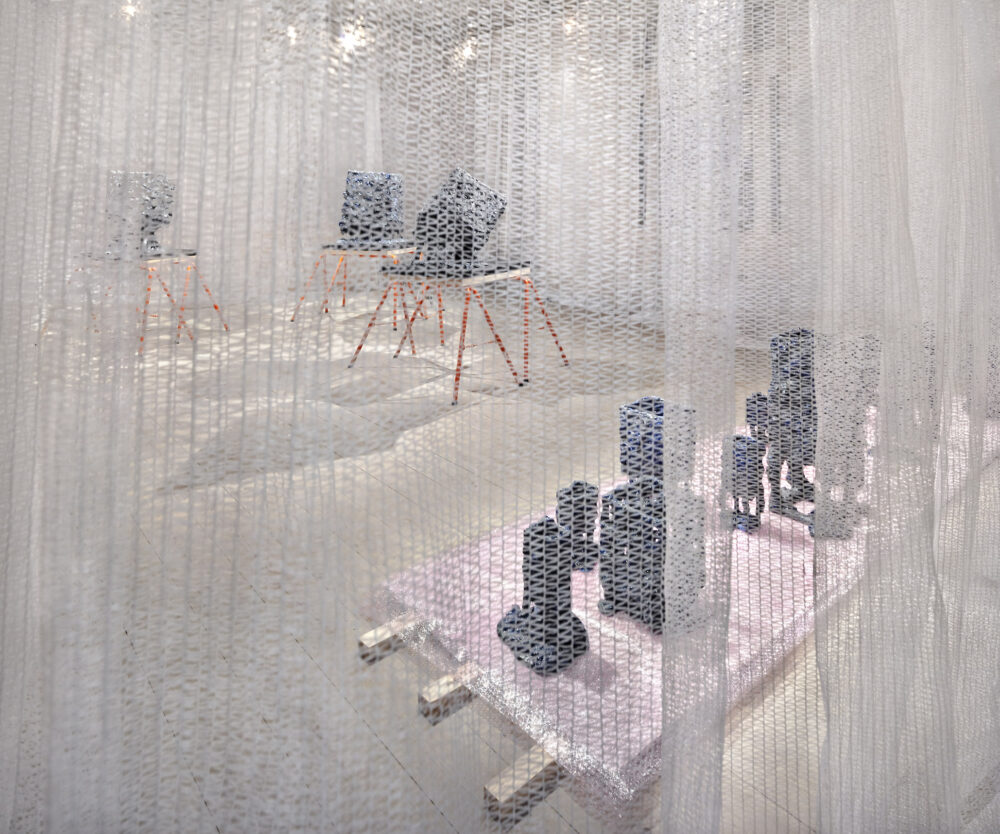
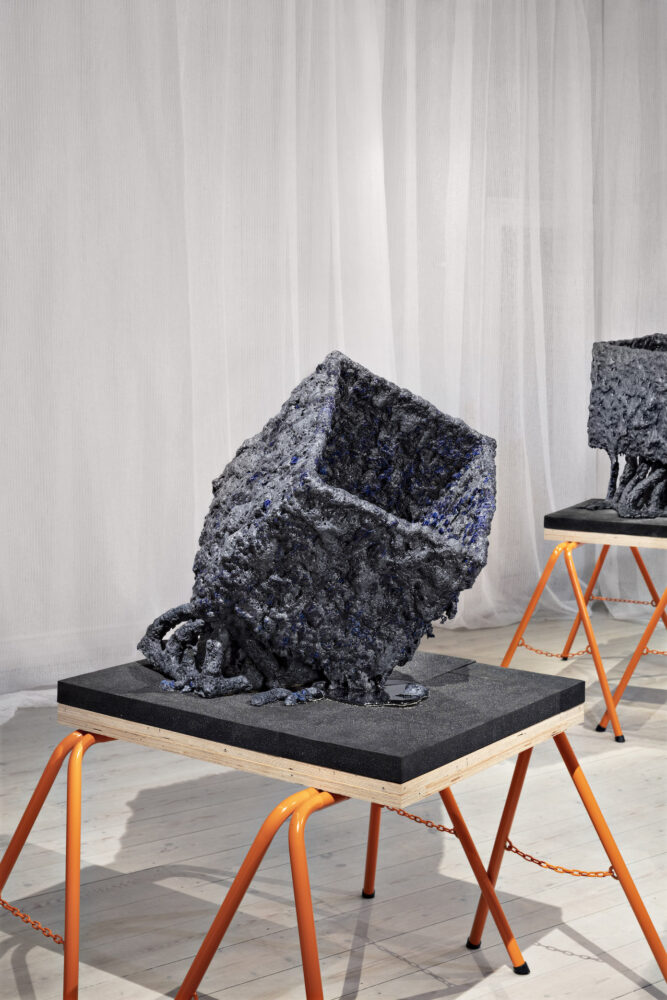
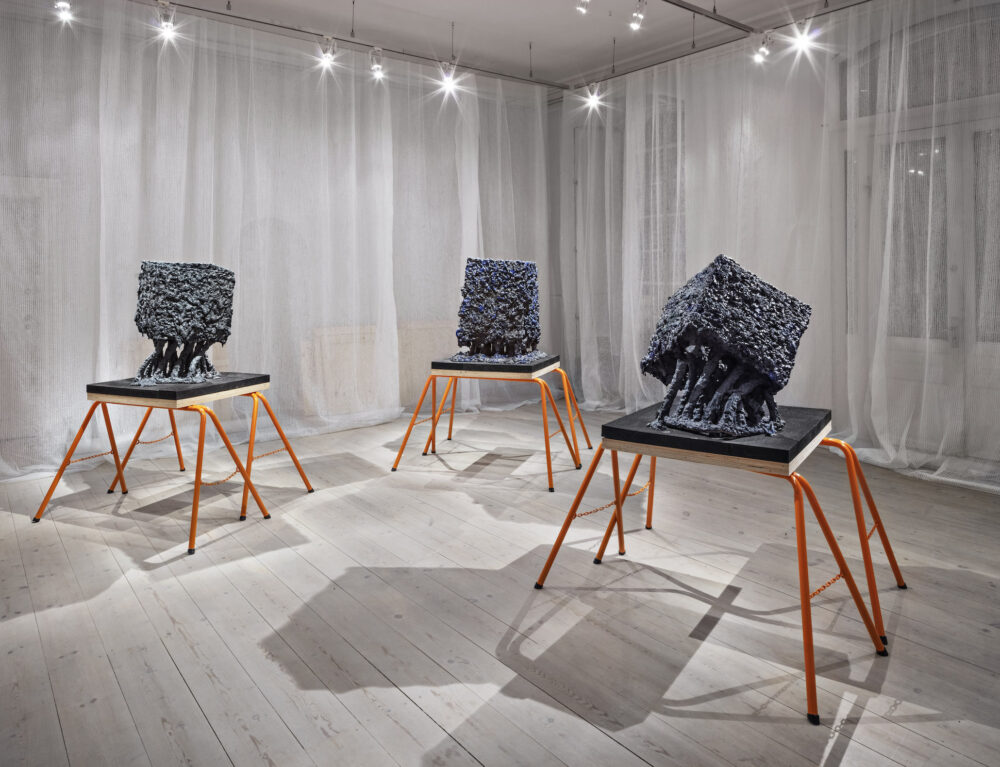
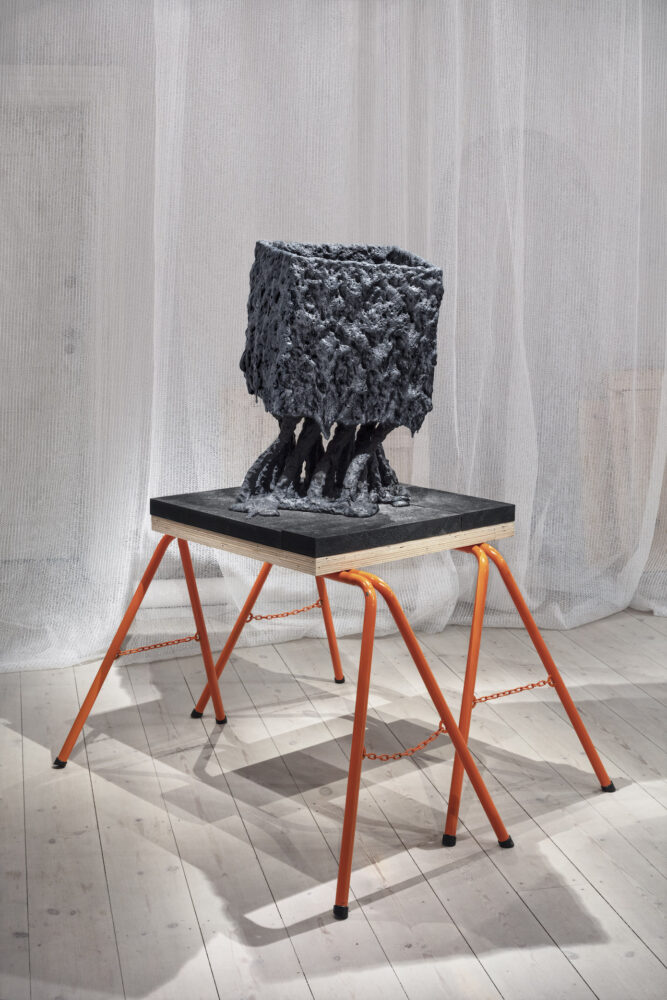
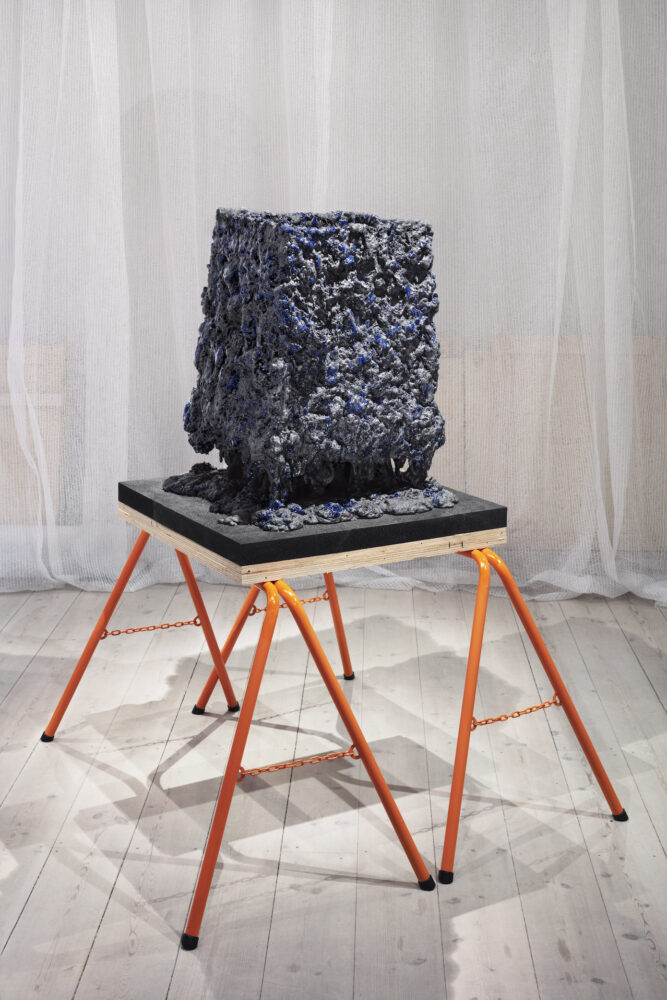
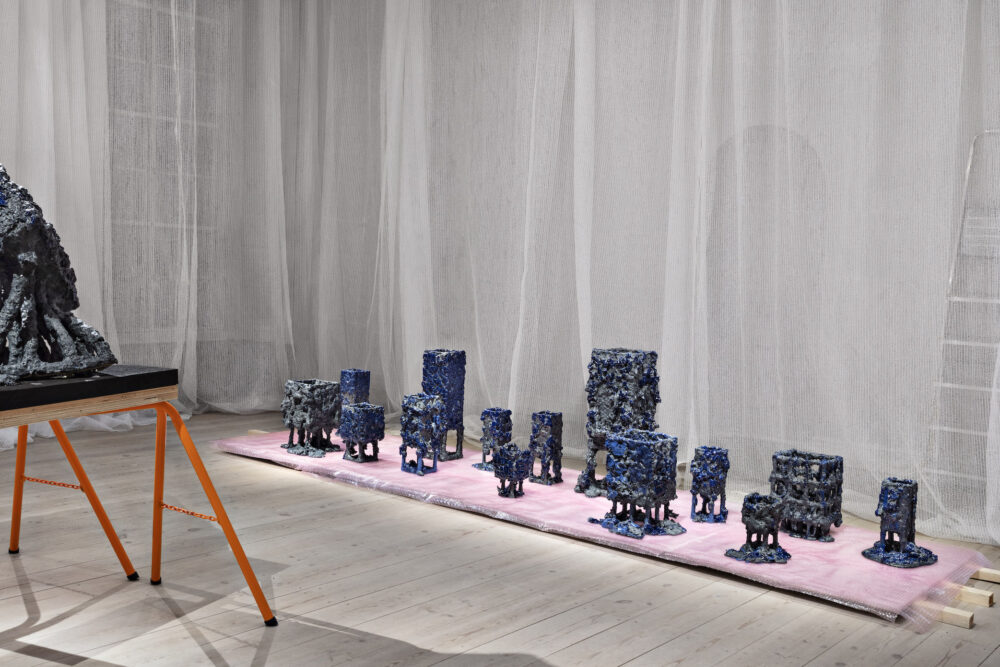
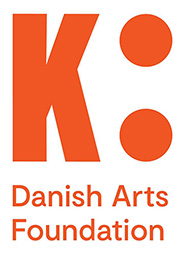
The Danish Arts Foundation awarded me a very generous work grant this year, thank you!
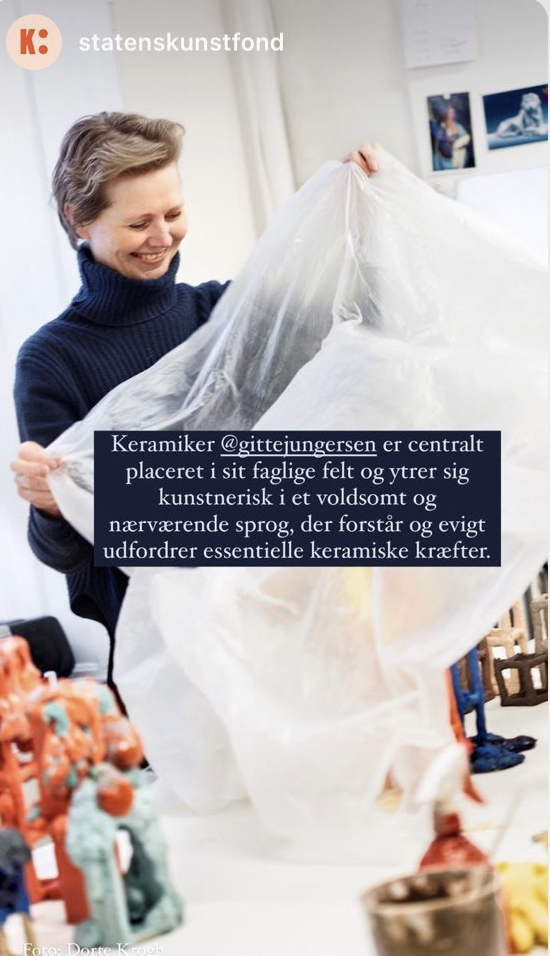
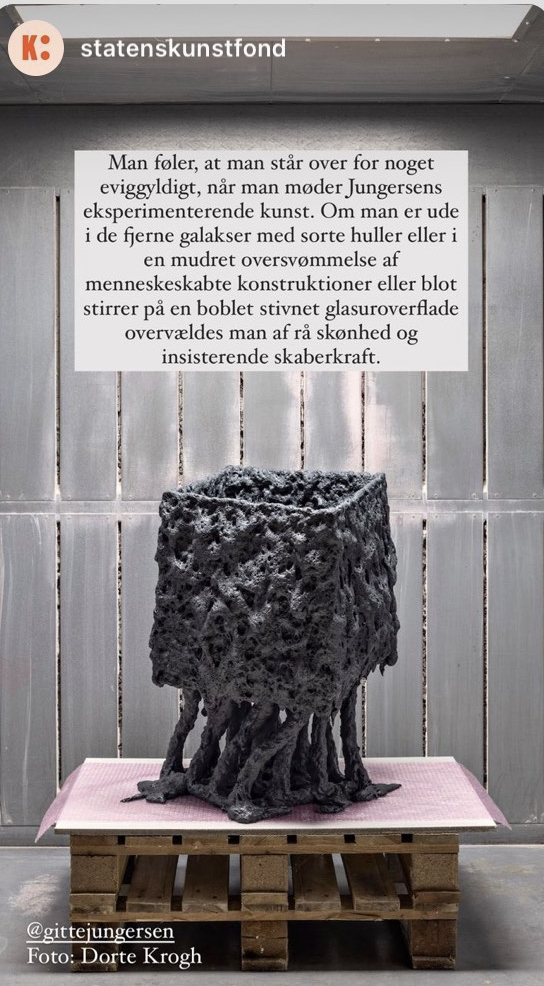
The foundation’s motivation: Ceramicist Gitte Jungersen is centrally placed in her professional field and expresses herself artistically in a fierce and present language that understands and continually challenges essential ceramic forces. Earth, chemistry, temperatures and gravity in constellations causing respective transformation, decomposition, dissolution and entirely new connections. You feel that you are facing something eternal when you encounter Jungersen’s experimental art. Whether you are out in the distant galaxies with black holes, or in a muddy flood of man-made constructions or simply staring at a bubbling congealed glaze surface, you are overwhelmed by raw beauty and insistent creative power. Many years of impressive work with glaze combinations and experiments with firing techniques have shown that Gitte Jungersen creates her very own characteristic structures, surfaces and colours.
https://www.kunst.dk/214-kunsthaandvaerkere-og-designere-modtager-arbejdslegater/gitte-jungersen
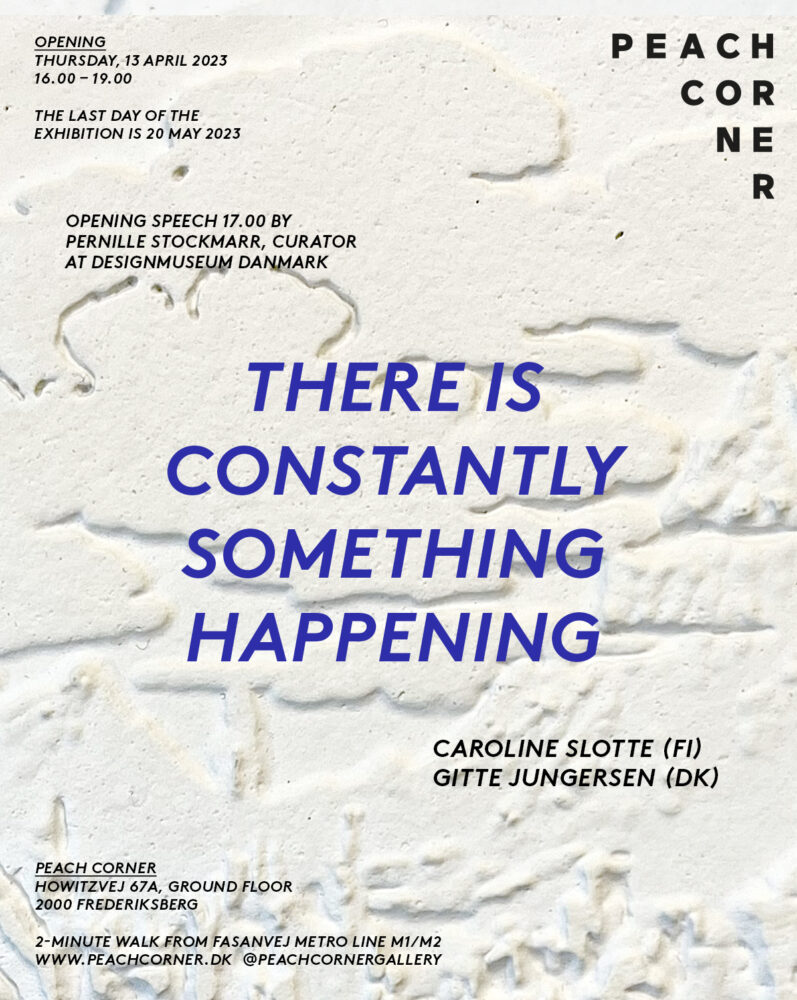
There is constantly something happening
Caroline Slotte (FI) and Gitte Jungersen (DK) 13 April – 20 May 2023
Pernille Stockmarr, curator at Designmuseum Danmark, gives the opening address at 17.00
Ceramics can be transformed in a split second if they are accidentally dropped and shatter. Or they can be slowly worn down – touched by hands, scratched by cutlery, their surface eroded by wind and weather. From the moment of creation, any object is also an incipient ruin, since, just as there is a ‘before’, there will also be an ‘after’. Over time, the objects are going to break up completely and enter into new physical manifestations.
Caroline Slotte’s works begin with antique porcelain plates. She sandblasts, grinds and cuts her way into the materi-
al, bringing new poetic images out of the familiar utilitarian objects. In her series Tracing, a miniature sandstorm has swept the original pieces, removing layer after layer of material. A landscape painted in cobalt blue, a sky, a cloud, a tiny person – the image is slowly eroded away, turning into white dust on the workshop floor. The flat blue painted scene gradually transforms into something akin to an imprint or an X-ray image, as if a memory of the image had sunk into the surface and is now slowly emerging as a three-dimensional recollection. In Under Blue Skies, all that remains is a few blue clouds. The clouds, which were originally added as background on the outer edge of the central image, move to the foreground, now accompanied by an outline of the elements that have been eroded away: a church, a tree, a floral border. The vanished areas can be glimpsed as negative forms in the white porcelain body.
In Gitte Jungersen’s large glaze objects, creation and destruction seem like two extremes that are closely connected. Piece #2 and Piece #3 consist of different glazes poured out in thick layers. Usually, even on a large sculpture, the glaze is only present as a thin layer, but here, the glazes take on a format that mirrors the human body. Like a blown-up detail or something seen through a microscope. All the glazes are coloured with cobalt oxide, which in the chemical make-up of the different glazes unfolds in varying colour shades and textures, from a greyish blue lava-like mass to a deep blue high-gloss shine. Glaze comes into being when different raw minerals coalesce and transform, becoming something new as a result of the firing’s dramatic, destructive and disintegrating forces. The transformation which occurs during the firing is retained as a frozen moment of a dynamic dimension that is felt and attracts like a quivering undertone in the finished work.

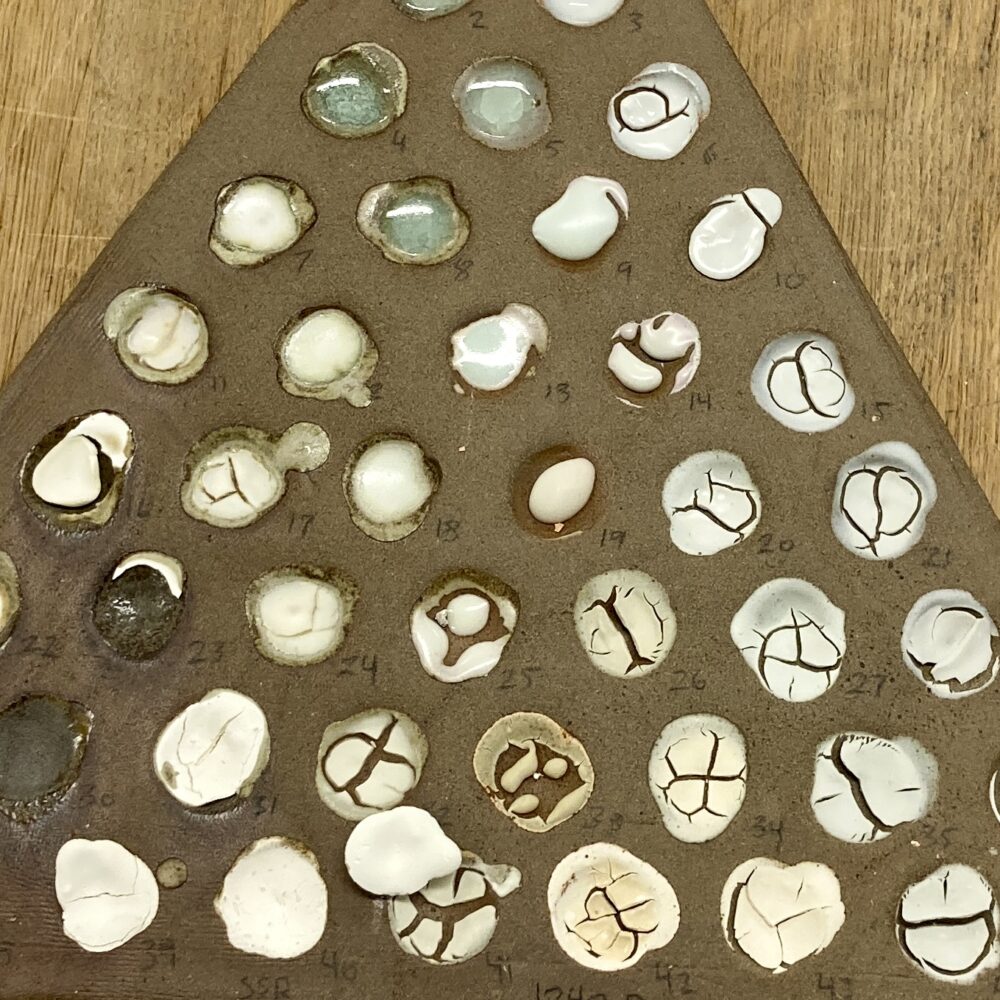
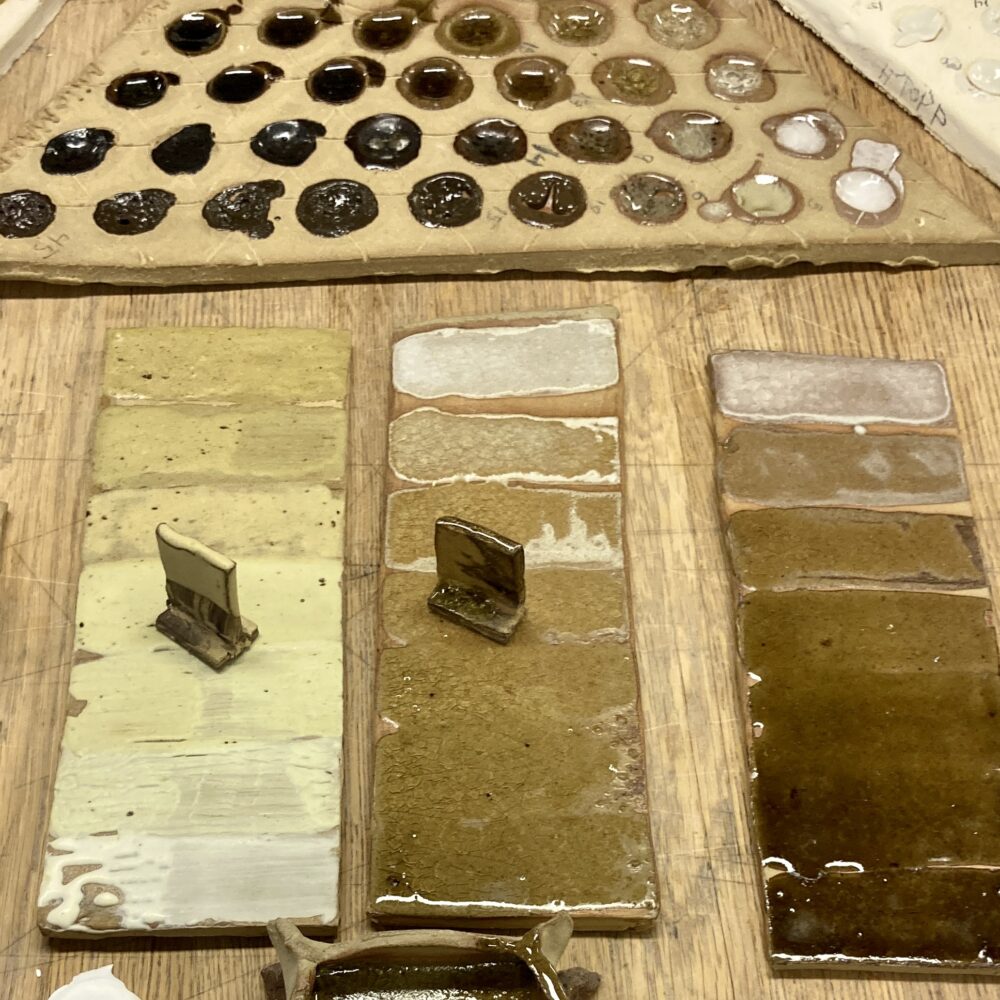
RUIN opens 25. November in Officinet, Bredgade 66, Copenhagen!
